You are reading the older HTML site
Positive Feedback ISSUE
16
november/december 2004
linn
Impressions: The Unidisk 1.1 universal player that Linn built - Part 1 (SACD stereo mode)
as reviewed by David W. Robinson

|
DAVID ROBINSON'S SYSTEM
LOUDSPEAKERS
ELECTRONICS
SOURCES
HEADPHONES
CABLES
ACCESSORIES
|
A 2004 Brutus Award winner!
I. In search of a reference grade universal player…
Over the past five years, I've gotten the opportunity to hear a number of SACD players, both stock and modified, in my listening room: various Sony, Philips, Marantz, Accuphase, and—of course—the Mighty Meitner line, my current reference standard for "best of the best." At shows and other listening rooms, I've heard some of the other alternatives from the likes of Sharp, Teac, Musical Fidelity, Pioneer and Shangling.
Having a lively interest in the format, I've also spent significant amounts of time exploring the world of modded players, reporting to our readers here at PFO the improvements that audio artisans like Richard Kern, Dan Wright, and Allen Wright have achieved with various approaches to improving the standard parts, power supplies, and circuitry in SACD players. These hotrodded players have been stereo units, and SACD plus CD only for playback.
I've only gotten to hear a couple of universal players over the past several years: a Pioneer, and a Teac. The Pioneer was eminently forgettable in sound, which was no surprise since it converted DSD to PCM as I recall. (Argh. Talk about changing wine into water, and silk into a sow's ear….) The Teac was more promising, but I heard that under show conditions, and so could draw no conclusions about it. Most of the rest of this category were entry-level machines, of little interest to me other than as potential platforms for modders to completely re-work. Over time, I set universal players aside…they had been a disappointment, and I had other things to do.
Enter the Unidisk 1.1
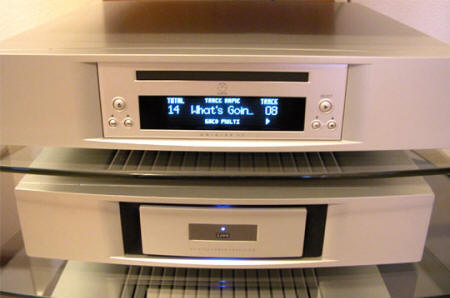
The Linn Unidisk 1.1 - just below it is a Linn 5125 5.1 channel amplifier
Things changed in early 2003. My sources at Linn told me that they were going to be releasing a reference-grade universal player, the Unidisk 1.1. It would support all the formats of interest to the audiophile/videophile, and it would do so without converting DSD to PCM, or compromising the engineering to jam in all the formats. I was certainly interested in hearing anything that would provide truly universal playback, and do so with the kind of performance and detail that Linn is legendary for.
I spoke with Brian Morris at Linn, about getting the 1.1 in for a review ASAP. As always, Brian was very helpful, and quite willing to get a review unit to PFO… but the Unidisk 1.1 was in short supply in 2003. I would have to wait for a few months. Patience is a virtue—even when a necessity, no? As it turned out, patience was a virtue; due to the serious interest that the Unidisk 1.1 attracted among consumers and reviewers, it was the early spring of 2004 before it finally arrived. I put it onto a system rack immediately, and started warming it up…
Description and specifications
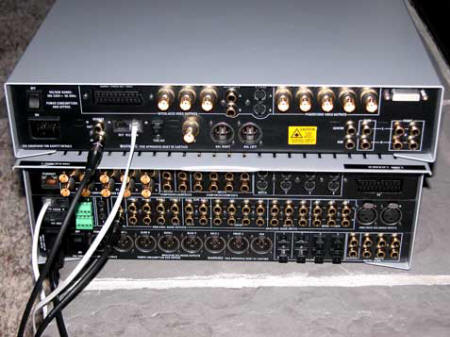
The Unidisk 1.1 (on top of the Linn Kisto controller) shows off its numerous I/O options: top row, left to right, SCART, 1 component video set (via gold-plated BNC), 2 composite video, 2 s-video, 1 progressive video set (via gold-plated BNC), 1 DVI. Bottom row, left to right, RCA remote control input/output, RJ-11 remote control input/output, TOSlink, S/PDIF, XLR analog stereo L/R, 1 set SACD analog stereo/multi-channel output, 1 extra set of RCA stereo L/R outputs. "Did we leave much out here?!"
The Unidisk 1.1 is Linn's current no-holds-barred essay at universal playback. As is usual with things Linn, there's an embarrassment of riches when it comes to features and specifications. The 1.1 supports a wealth of formats: SACD (stereo and multi-channel), DVD-A, CD (including enhanced CD/VCD), CD-R and CD-RW, DVD (video), DVD-R, DVD-RW, DVD-R, DVD-RW, Dolby Digital, DTS, JPEGs, Windows Media Audio, and MP3. This is serious overachievement in a digital world that is spawning new formats at a very high rate; most anything that an audiophile/videophile could want at this time (apart from HD on a disc!) is aboard.
The input/output array is superior: everything from multiple remote controls to multi-channel is here. (See photo and caption above.) There are no inputs for digital processing of other digital sources; then again, since just about everything on a silver disc can be played back in the Unidisk 1.1, you really don't need it, and will definitely not miss it.
SACDs and DSD are processed using Linn's DSD decoding section in its SACD engine. DVD-A's are handled by an ESS decoding section, capable of PCM resolutions ranging from Red Book all the way to 192/"24-bit". While this review will focus on the SACD stereo playback of the 1.1, it is worth noting that the DVD playback is operating at 12-bit and 54MHz, and supports both NTSC and PAL formats. Also universal is the innovative switching power supply of the 1.1, automatically setting itself in a voltage range from 90 VAC to 240 VAC, and either 50 or 60 AC Hz.
One of the best things about the Unidisk 1.1 is the fact that this excellent collection of capabilities comes in such a trim and attractive package. Measuring only 15" wide by 14" deep by only 3 3/8" high, the 1.1 is very compact. It tips the balance at only 10.75 pounds, making it very easy to place or move (not true of all too many fine audio designs!) And frankly, having schlepped a lot of audio gear in my time, I'll usually vote for toting something less than the 800 pound gorilla.
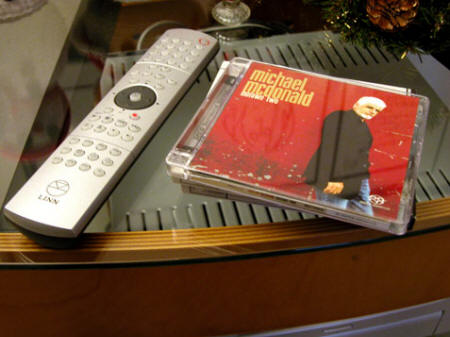
The Unidisk 1.1 remote control with another fine creative effort, Michael McDonald's Motown Two SACD; the vents of the Linn Kisto is underneath the glass.
The remote control of the 1.1 is a nice piece of work, allowing all basic functions, but also including a number of more advanced video functions. The Linn remote also allows for integration with the Linn Kisto home theater controller/the Linn Knecht system, with all audio and video functions centralized on one controller. The function buttons are all positive and clearly marked, with good heft and feel.
I'll talk more about the 1.1's surround sound/home theater capabilities in a future review of the entire Linn system; for now, I want to concentrate on its stereo performance with SACDs.
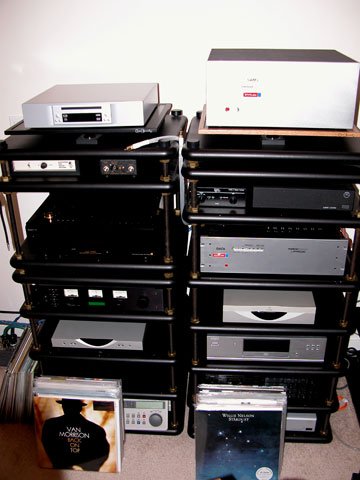
The Linn Unidisk 1.1 in its place (left rack, on the top shelf) during extended listening in stereo mode last summer. The EMM Labs SWM-3 preamp is to its right; the Meitnerized Philips SACD 1000 is just north of the Wilson Nelson 45 RPM LP set at bottom right, while the EMM Labs DAC6 is two shelves above the SACD 1000, one shelf above the Linn CD-12.
The sound
I ran the 1.1 in balanced output mode to the EMM Labs SWM-3 preamp via JENA Labs XLR Symphony interconnects, treated with the Walker Audio SST Contact Enhancer. I didn't listen to the RCA outputs during this evaluation (though I am currently doing so for my notes on the surround sound system review). For a period of several months, I gathered impressions on the Unidisk 1.1, alternating it with my Meitnerized Philips SACD 1000 (since replaced with the EMM Labs CDSD)/EMM Labs DAC6 combination. At the far end of the line (a long run of shielded JENA Labs Solos treated with the SST Contact Enhancer) was a pair of the Linn Klimax monoblocks. These in turn ran to the very fine Kharma Grande Ceramiques via a bi-wired pair of JENA Labs Pathfinder speaker cables, likewise treated with the Walker Audio SST Contact Enhancer. Power cabling was provided by Cardas.
First off, I note that you should give the 1.1 some 50-100 hours of break-in if you want to hear it hitting its stride. For the first day or two, it was a bit congested and thin sounding. This is nothing unusual, since in my experience all gear has one level or another of break-in. (I have seen SACD gear and mods that take upwards of 400 hours to really hit their stride, so the 1.1's initial warm-up isn't that bad.) Thereafter, it began to bloom very nicely, and started to reveal its sonic character, as I played many dozens of reference SACDs through it.
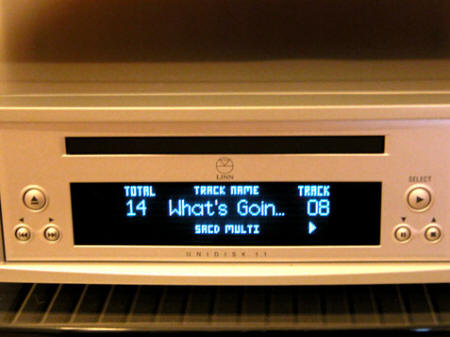
The Unidisk 1.1 quickly showed itself to be operating at a world-class reference level on stereo SACDs. The sound was truly excellent, having the following general characteristics to my ear:
-
Transparency in the 1.1 was superior to just about any other SACD player I've heard, with the sole exception of Ed Meitner's EMM Labs CDSD/DAC6 or DCC2 combination. You know, it's funny: the further along I get in my audio voyage, the more I value this aspect of audio reproduction. Designs that simply aren't there… that get out of the way of the recording… that replace plastic panes into the music with pure crystal, or better yet, with an open doorway into a room that you can walk into and take a seat in… well, that has moved to the top of the heap for me. Are all other audio attributes subordinate to this? I wonder…. Anyway, the 1.1 does exceptionally well in this category.
-
High frequency extension—no problem. The 1.1 does not give you the sense of being rolled off in its presentation, even with "high shimmer" SACDs like DMP's The Quality of Silence, still a reference for naturalness and ease, and an ongoing example of how good DSD can be. I have heard a number of lesser SACD players (before modification) that seem somewhat dark in their presentation, even when they're set to deliver 100kHz signal bandwidth. It's as though you're close to the room… maybe even part-way in the door… but not in the room. (All Red Book CDs have this feeling to me, even on the CD-12 or the EMM Labs front end.) This doesn't happen with the Unidisk 1.1, which places it in a very limited group of stock players that really show the possibilities of the format without requiring a great deal of re-working. (So far, among the modded players, Allen Wright's Vacuum State mods seem to be closest to the kind of "you are there" extension that I prefer to hear. I've just received a Tube Research Labs modded Sony 595, though…we'll see if Allen is alone in getting that kind of performance.)
-
Low frequency rendition and control is very fine with the 1.1. DSD and SACD have a very natural advantage in high frequency extension and phase correctness over Red Book PCM, but I find that this superiority also extends (surprisingly) to the lower frequencies, as well, where PCM's flaws are not nearly so apparent. The 1.1 nails low bass with aplomb. Reference SACDs for deep bass like Spitball's Pop Condition or Satriani's Engines of Creation (wish that Glory would come out on SACD!) were no problem for the Unidisk 1.1, which didn't blob the bass, but presented it with roundness and control.
-
Mid-frequency response was uncolored and lacked the nasality or honkiness that all of the inexpensive (and some of the more expensive) stock SACD players are born with. I like the tonal integration of the 1.1's midrange; it blends seamlessly into both the higher and lower frequency ranges.
-
Timbral presentation was nicely done. I like the sense of "pluck" that the Unidisk 1.1 gives to classical violin or harp. Sonic textures have detail without steeliness, which is particularly pleasant with massed strings on reference-grade DSD recordings like the stellar Mahler cycle done by the San Francisco Symphony under Michael Tilson Thomas' direction. (By the way, if you haven't purchased every single one of these superb pure DSD recordings, you are missing out in a very big way. These are sine qua non for the classical lover who enjoys SACD.) With the 1.1, strings feel like strings, brass feels like brass, and percussives feel like percussives. Another excellent SACD to use is First Impression Music's SACD sampler; the timbral resolution on cuts like The Swan, with its marvelous cello intonation, are not only musically beautiful, but very helpful to the discriminating audiophile who wishes to check the rightness of timbre within his or her system.
-
Dynamic range was excellent, with no sense of the 1.1 pooping out on powerful transient swings, or a sudden movement from pianissimo to fff. The switching power supply seems to be very nimble, without giving a sense of strain or being overworked. The Mahler 2nd, 3rd or 6th in the MTT sequence mentioned above are excellent tests for what the Unidisk can do with dynamics… and what Red Book CD can never hope to do.
-
Soundstaging with the 1.1 was superior, in direct comparisons stretching nearly as wide as the EMM Labs CDSD/DAC6 reference system, though not as deep. It was very satisfactory nonetheless. The MTT/SF DSD Mahlers are an excellent test for this quality, as is Winston Ma's aforementioned First Impression Music reference SACD.
-
Stereo imaging was pleasantly precise, and allowed the discernment of instrument placement in reference recordings like the UMG SACD of Getz/Gilberto and Muddy Waters' Folk Singer. Some ‘philes claim to eschew the importance of imaging, claiming it to be an "artifact" of stereo microphony. "It doesn't sound that way in the concert hall," they claim. I disagree; I find that one of the real pleasures of fine audio is precisely this ability to take pleasure in discerning aurally how instrumentalists and performers were laid out in a stereo field by the recordist/audio engineering group. Thus, I value this quality very highly. In that regard, the 1.1 did very well against the Meitnerized Philips SACD 1000/EMM Labs DAC6, though the margin increased noticeably in favor of the Meitner front end when the EMM Labs CDSD transport was substituted for the SACD 1000. Nevertheless, one cannot fault the imaging of the 1.1, and the clarity of its imaging is a compliment to its control of jitter.
In sum, the combination of plusses that the Unidisk 1.1 offers in its audio performance makes it a top flight SACD player in my book. At no point did I find myself tiring of listening to it for extended periods… as in "months"… which has not been the case with most other stock SACD players (the EMM Labs front end being the sole exception). A rich combination of beauty, versatility, and glorious sonics, the Unidisk 1.1 is a superb achievement at the highest level of fine audio engineering.
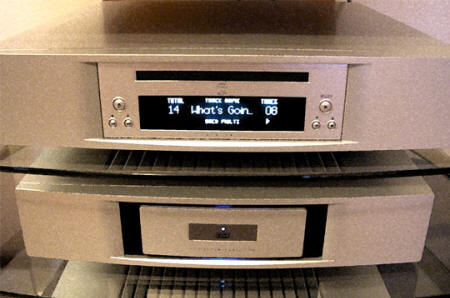
Conclusion
Universal players are hostages to compromise; "jack of all trades, and master of none" is a pretty fair assessment of what I'd heard in universals—until the Unidisk 1.1 arrived. I wasn't sure what to expect with it, though I've been extremely impressed with Linn's digital efforts since the advent of the exceptional CD-12.
I needn't have worried; in a nutshell—and universal player or not—the Unidisk 1.1 is a stellar SACD stereo player, occupying the very first rank of all SACD playback that I've heard (and I've heard a fair number of designs). In my current pantheon of audio experiences, I would place the 1.1 second only to the EMM Labs CDSD transport/EMM Labs DAC6 or DCC2 for ultimate sound in SACD stereo playback. Given the fact that the one-box Unidisk 1.1 was never intended by Linn to be an ultimate SACD "statement" product, this is the highest praise that I can give it.
Stock form, right out of the box, the 1.1 waxes just about anything else on the block for SACD playback…and then the bloody thing plays back just about everything else on a disc! Audiophiles and videophiles, take note: the Linn Unidisk 1.1 is a very serious, world-class SACD platform, satisfying to even the most discriminating tastes. If you are looking for universal playback with a minimum of compromise and a maximum of excellence, you can stop searching. The Linn Unidisk 1.1 is it!
It is for this reason that I would give the Unidisk 1.1 a "Ye Olde Editor's ‘Very Highest Recommendation,'" and have awarded the 1.1 a 2004 Brutus Award for SACD players—one that is very richly deserved. I only hope that we eventually see Linn essay a "statement" level SACD player one day; given Linn's sterling achievements in recent years, it would undoubtedly give everything else on the planet a very serious run for the money. David W. Robinson
Unidisk 1.1
Retail: USD $11,000
Linn
web address: www.linn.co.uk
